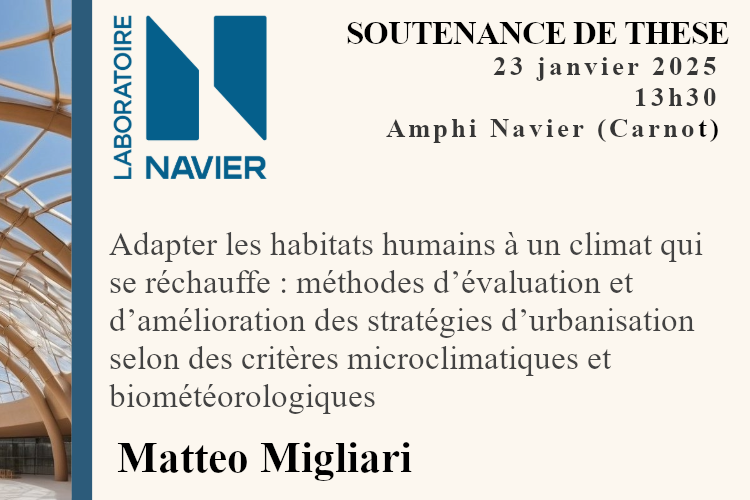
Soutenance de thèse – Matteo Migliari
- Post by: sebastien.gervillers
- 14 janvier 2025
- No Comment
Matteo Migiari, doctorant au sein de l’équipes Matériaux et Structures Architecturées et de l’Atelier Franck Boutté soutiendra sa thèse « Adapter les habitats humains à un climat qui se réchauffe : méthodes d’évaluation et d’amélioration des stratégies d’urbanisation selon des critères microclimatiques et biométéorologiques » le jeudi 23 janvier à 13h30 dans l’amphithéâtre Navier (Carnot).
Composition du jury :
- Denis BRUNEAU – Professeur, ENSAP Bordeaux (Rapporteur)
- Stevan SAVIC – Professeur, University of Novi Sad (Rapporteur)
- Julien WAEYTENS – Directeur de recherche, Université Gustave Eiffel (Examinateur)
- Sophie HERPIN – Maître de conférences, Institut Agro Rennes (Examinatrice)
- Dragan MILOSEVIC – Maître de conférences, Wageningen University (Examinateur)
-
Auline RODLER – Chargée de recherche, CEREMA (Examinatrice)
-
Olivier BAVEREL – Professeur, École Nationale des Ponts et Chaussées (Directeur de thèse)
-
Loïc CHESNE – Directeur de projets, Atelier Franck Boutté (Co-Directeur de thèse, Invité)
- Franck BOUTTE – Fondateur et président, Atelier Franck Boutté (Invité)
La soutenance sera diffusée au lien suivant : https://docs.google.com/forms/d/e/1FAIpQLSe21lfG1r5dLWb1R1FajMTmZUW3OpQLQErnmJ7X96wx2CTHZA/viewform?usp=header
Résumé
Adapting to and mitigating climate change are essential for the habitability of cities, home to most of the global population and highly vulnerable to summer overheating. Hot outdoor spaces drive people indoors, increasing air conditioning use, which expels heat outside, intensifying outdoor heat stress. Breaking this feedback loop requires collective solutions. Improving public space comfort encourages outdoor activities while supporting climate change adaptation and mitigation by safeguarding well-being and reducing summer greenhouse gas emissions.
This thesis explores urban strategies to adapt to a warming climate, rethinking current practices and proposing sustainable, context-driven solutions from a project’s early stages. By comparing urban heat island (UHI) and outdoor thermal comfort (OTC), OTC was identified as the more suitable parameter to evaluate the liveability of outdoor spaces. The Metamatrix of Thermal Comfort, a novel classification methodology, facilitates the rapid selection of appropriate outdoor thermal comfort indices (OTCIs) and tools, preventing mischaracterisation of complex microclimatic ambiences. Through its application, the Universal Thermal Climate Index (UTCI) and ENVI-met software were selected for studying OTC in French urban and natural areas during both summer and winter.
The ENVI-met workflow was enhanced with custom Grasshopper algorithms, expediting modelling and result analysis while enabling advanced statistical evaluations beyond the commercial version. Based on ENVI-met results, a UTCI bioclimatic chart was created, identifying shade as the most effective lever to reduce thermal stress and examining the contrasting role of summer winds on OTC. As unshaded areas are most vulnerable to heat, the microclimatic and biometeorological impacts of multilayered urban pavements were analysed through ENVI-met simulations to identify solutions for these zones. Irrigated grass proved most effective for mitigating both UHI and OTC, while wood performed poorly on both.
The study revealed a paradox: reflective “cool" pavements, though reducing UHI, can increase pedestrian thermal discomfort by reflecting more radiation. This highlights the conceptual difference between UHI and OTC and suggests rethinking current street albedo distributions, featuring dark roadways coupled with lighter sidewalks. A reversed approach, with lighter roadways and darker sidewalks, could reduce urban overheating and thermal stress, with minimal winter rebound effects.
Results were validated via a participatory experiment with 75 volunteers during the 2022 heatwave (HW), where most reported higher thermal stress on reflective pavements than on absorbent ones, contrary to their expectations. Microclimatic data, participants’ thermal sensation votes (TSV), and physical characteristics were analysed using artificial intelligence. Findings revealed that OTC determinants are largely objective, driven by microclimatic conditions and material properties, supporting the use of objective OTCIs for OTC assessment.


